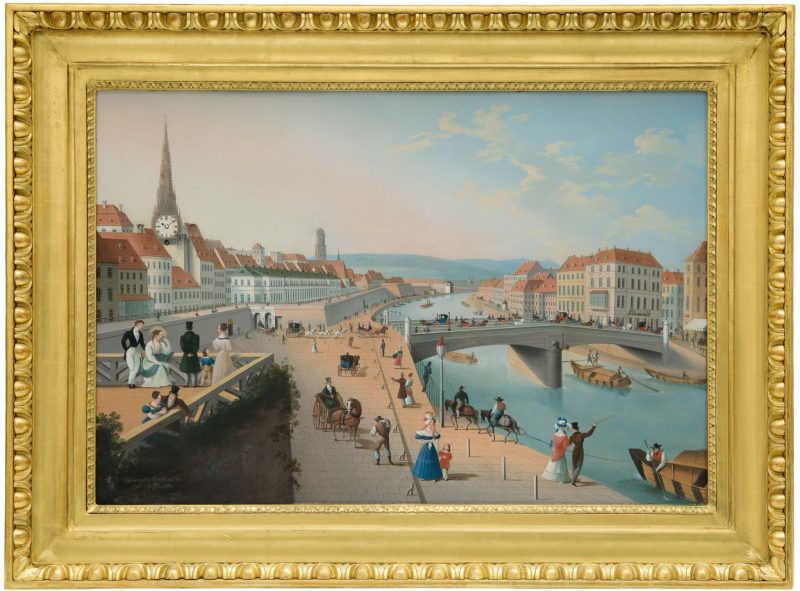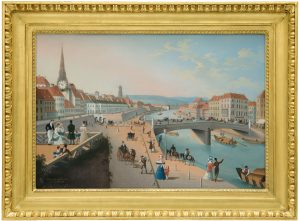Vienna, second quarter of the 19th century
- signed
- lower left: "C. L. Hoffmeister"
- Case
- gilt bull’s eye frame
- Movement
- verge escapement, Viennese grande sonnerie on wire gongs, repeater, musical movement wit two tunes by Slawik und Preiszler in Prag, No. 516 3724
- Technique
- oil on metal
- Measurements
- 30×40 ½ in
This highly museum-quality picture clock is the work of the most famous painter of Viennese picture clocks – C. L. Hof(f)meister – and shows a historical view of the Ferdinand Bridge (today Schwedenbrücke). The bridge was named in honor of the then Crown Prince Ferdinand. The date of construction in 1819 (MDCCCXIX) is inscribed on the central pillar. In Hoffmeister views of the Ferdinand Bridge, the viewer’s point of view is usually on the other bank of the Danube Canal in Leopoldstadt. The present, even rarer variant, however, shows the view from the inner-city bank, more precisely from the terrace of the Biber Bastion – part of the city fortifications along today’s Schwedenplatz.
The higher viewpoint makes it possible to recognize the exact construction of the Ferdinand Bridge: Low walls separated the two central roadways from the two outer pedestrian walkways. The New-Rotenturm-Gate is embedded in the eastern continuation of the city wall, the so-called Gonzaga Bastion, which has just been passed by the imperial court carriage with a team of six white horses. The high south tower of St. Stephen’s Cathedral, in which the clock face is integrated, rises within the city walls. The tower of Maria am Gestade and the twin towers of the Serviten church in Rossau also rise above the city.
Upstream one can see the Karlskettensteg, a pedestrian bridge with toll towers at both ends and the Vienna Woods hills in the distance. On the right bank of the Danube Canal, in Leopoldstadt, the noble Café Wagner with its elegant, glazed bay window catches the eye. The coffee house, which was one of the oldest in Vienna, was rebuilt by one of the most important architects of Austrian classicism, Josef Kornhäusel, during the construction of the bridge.
Numerous market barges illustrate the role of the Danube Canal as the city’s lifeline and transportation artery, connecting Vienna with important cities such as Ulm, Regensburg, Passau and Linz. Some of the boats depicted are of the „Ulmer Schachtel“ type, simple barges with or without superstructures, which were only intended for the downstream journey and were sold in Vienna as timber and firewood. The merchants moored at the “Schanzel”-market, where they were allowed to sell the imported goods directly from the boat. One of the boats is pulled upstream towards the market by tow-horses. This was strenuous work for the draught animals, which were then washed in the horse pond, which is also depicted.
We have only come across this rare variant of the Vienna view with Ferdinand’s Bridge twice before in our decades of dealing with Viennese picture clocks. We are therefore all the more pleased to be able to present this highly museum-quality piece of Viennese clockmaking and city history to you!

